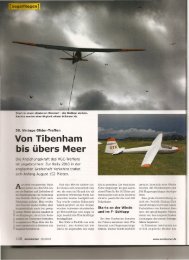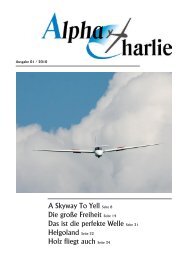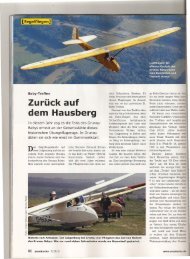Download - Vintage Glider Club
Download - Vintage Glider Club
Download - Vintage Glider Club
You also want an ePaper? Increase the reach of your titles
YUMPU automatically turns print PDFs into web optimized ePapers that Google loves.
FEATURE<br />
Above: Mucha in original colour scheme as delivered to Lausanne in 1959<br />
Below: BGA5176 with canopy open<br />
off the ground, and to balance the Mucha<br />
to run on its single wheel. Time to<br />
1,000 metres (3,280ft.) AGL behind the<br />
Auster “Tugmaster” with only pilot in<br />
the tug was 7½ minutes.<br />
The Mucha has exceptionally pleasant<br />
and well-harmonized controls. The general<br />
feel is similar to, but better than an<br />
Olympia, and the ailerons, in particular,<br />
are among the best so far encountered in<br />
any sailplane. There is, nevertheless,<br />
sufficient aileron drag to call for rudder<br />
when rolling rapidly into, or out of<br />
turns.<br />
The Mucha is unstable laterally, and if<br />
left to its own devices in a turn, the turn<br />
will steepen, and gradually turn into a<br />
dive. As, however, the airbrakes may be<br />
opened at any speed up to the maximum<br />
permitted for the aircraft, and when<br />
opened, will restrain the Mucha to within<br />
this limit, the aircraft can take care of<br />
itself under most conditions.<br />
The Mucha can be trimmed to fly<br />
level, hands off at any speed within the<br />
normal operating range; if disturbed, it<br />
will oscillate fore and aft. For example,<br />
after trimming to fly hands off at<br />
80km./hr (43 knots) a disturbance produced<br />
an oscillation in which the speed<br />
varied between 76 (41kts) and 84 km./hr.<br />
(45kts), but which slowly dampened out;<br />
the lower the speed at which the aircraft<br />
is trimmed to fly, the longer the dampening<br />
out takes. Opening the airbrakes<br />
stopped the oscillation at once, and the<br />
Mucha settled quickly each time into a<br />
steady glide close to the speed at which it<br />
was originally trimmed, although of<br />
course steeper. Rate of descent in still<br />
air, with airbrakes fully opened at 80<br />
km./hr. (43 knots) was about 4.5<br />
metres/sec. (14.7 ft./sec.), representing a<br />
glide angle near a one-in-four, which is a<br />
satisfactory steep approach for landing in<br />
fields over obstacles.<br />
Directionally the Mucha is stable and<br />
the rudder, though never heavy, is powerful<br />
and effective down to all speeds,<br />
including below the stall.<br />
Stalling the Mucha is interesting, and<br />
special attention was paid to it. The first<br />
indication of the approaching stall<br />
occurred at 54km./hr. I.A.S. (29.1 knots)<br />
in the form of a faint rumble, which<br />
could be both heard and felt, and appeared<br />
to come from somewhere down by the<br />
tail. This cause is possibly the initial<br />
breakdown of airflow over the centre-section,<br />
so that there is a small amount of<br />
turbulence over the tail unit; the effect is<br />
much less than the usual pre-stall buffet.<br />
At 52km./hr. (28 knots), the aircraft<br />
begins to feel as though it were balanced<br />
on a knife-edge, and it is difficult to hold<br />
it level with ailerons alone; at<br />
50/51km./hr. (27Knots) I.A.S. the aircraft<br />
cannot be held level, and one or<br />
other wing drops at this point: a spin<br />
will develop unless prevented.<br />
In level flight, with airbrakes closed,<br />
the point of stall could be reached before<br />
the stick was fully back. Further rearward<br />
movement of the stick at this point<br />
accentuated the wing drop; but at no time<br />
was a spin inevitable, and the Mucha<br />
responded immediately to the appropriate<br />
recovery action. Little height need be<br />
lost, and in fact a series of three full<br />
stalls and recoveries, together with turns<br />
between each to look around the sky,<br />
resulted in a total loss of height of only<br />
150 metres (490 ft.).<br />
With airbrakes open, the stalling characteristics<br />
are not noticeably different.<br />
The sequence starts at 2km./hr. higher<br />
speed, and a slightly greater rearward<br />
pressure and movement is needed on the<br />
control column to bring the aircraft to<br />
the stall, but that is all.<br />
As this pilot with parachute weighs<br />
220lb, (98kg) the Mucha was flying<br />
close to its maximum all-up weight of<br />
718 lb. (326kg) for these tests, and the<br />
c.g. would be near its forward position.<br />
Nothing was found in the stalling<br />
characteristics of the Mucha in this test<br />
which could be beyond the competence<br />
of a properly trained pilot, for it must be<br />
assumed that such pilots have been adequately<br />
trained in spin recovery. If this is<br />
so, the Mucha can be considered an<br />
excellent club and training aircraft, for it<br />
will encourage pilots to fly with understanding<br />
and skill, and it will provide<br />
valuable experience, which is beyond the<br />
capacity of the completely foolproof aircraft.<br />
It is very likely with this idea in<br />
mind that the Mucha has been adopted by<br />
Polish clubs.<br />
In the circuit the Mucha is particularly<br />
easy to handle. The powerful airbrakes<br />
VGC News No. 123 Spring 2008 43







